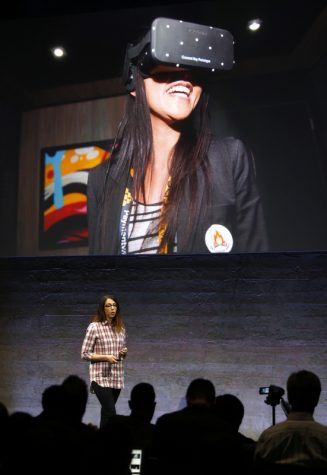Troy Wolverton: Virtual world meets virtual reality as Minecraft heads to Oculus Rift
August 23, 2016

Anna Sweet, head of developer strategy at Oculus, helps introduces the Rift virtual reality headset during a media event at Oculus in San Francisco, Calif., on Thursday, June 11, 2015. (Karl Mondon/Bay Area News Group/TNS)
By Troy Wolverton
The Mercury News
(TNS)
If you have an Oculus Rift, you can now use it to explore and build in the world of Minecraft.
Microsoft-owned Mojang announced Monday that it has updated its Lego-like virtual world game to support the new virtual reality headset from Facebook’s Oculus unit. Mojang customized the game in numerous ways, including changing what happens when users turn around in their worlds, to better the experience for Rift users.
“Minecraft has always been on the forefront of technology,” Saxs Persson, a studio manager at Microsoft and a member of its Minecraft team, said in a promotional video. “So we’re trying as much as possible to have Minecraft available wherever people want to create.”
Bringing a virtual-world game to a virtual reality headset is likely to benefit the companies behind each product, analysts said.
“It’s definitely a good fit,” said Billy Pidgeon, an independent game-industry analyst.
Users will be able to play the new Rift-compatible version of Minecraft with a keyboard and mouse or an Xbox One controller. They’ll also be able to experience the game in two different ways.
They can immerse themselves in the virtual world they are building. Alternatively, they can shift to something Mojang calls the “Virtual Living Room,” which allows them to play Minecraft as they would in the real world, by viewing it on a screen in a room in their house — in this case, a virtual screen in a computer-generated house. The mode was designed to “give players a break” from being fully immersed in their Minecraft worlds, Persson said.
One of the tweaks Mojang made to the game was to make it move less smoothly when users turned their heads quickly. Instead of shifting their view seamlessly, the game jumps in 22.5-degree increments in an attempt to make the game less disorienting and uncomfortable to players.
There’s an active debate in virtual reality circles about how long gamers can endure virtual reality experiences. Some people are particularly susceptible to simulator sickness, which happens when users do things in a virtual world that don’t correspond with the motions of their actual bodies.
With Minecraft and other virtual reality experiences, “there will probably have to be a lot of tweaking to see how people react to it,” said David Cole, principal analyst at DFC Intelligence, a game-industry consulting firm.
The Rift-compatible version of Minecraft is only available for the Windows 10 edition of the game. That edition of the game costs $10 but is available free to users who have previously purchased a Mac or Windows version. Mojang is offering the Rift compatibility as a free add-on to the Windows 10 edition.
Only a minority of Windows users are on Windows 10. But that’s not likely to be a major factor in demand for the Oculus-compatible version of Minecraft, said Cole. The much bigger factor is the sheer expense of the Oculus Rift system and the computers needed to run it. Oculus charges $600 for Rift, but to power the system, users need to also have a computer that costs a $1,000 or more.
Upgrading to Windows 10 is “much easier to do than going out and dropping a couple thousand dollars on the hardware needed to play the game,” Cole said.
The Rift iteration of Minecraft is the second version of the game that’s been customized for a virtual reality headset. Mojang in April released a version for Samsung’s Gear VR headset.
———
ABOUT THE WRITER
Troy Wolverton is a technology columnist for The Mercury News. Reach him at twolverton@mercurynews.com or follow him on Twitter @troywolv.
———
©2016 The Mercury News (San Jose, Calif.)
Visit The Mercury News (San Jose, Calif.) at www.mercurynews.com.
Distributed by Tribune Content Agency, LLC.








